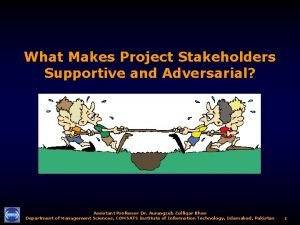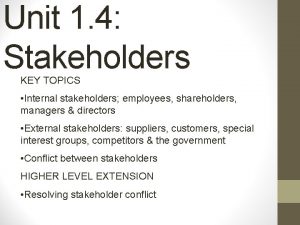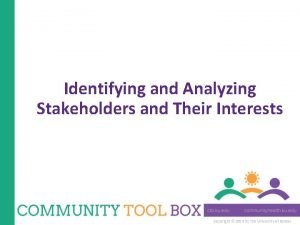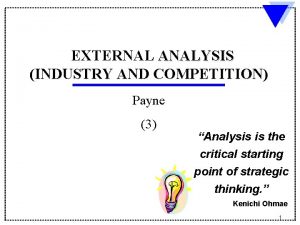1 TOPIC 1 4 Stakeholders Introduction 2 Stakeholders






















- Slides: 22

1 TOPIC 1. 4 Stakeholders

Introduction 2 Stakeholders: “People & organizations with an interest in a business. ” Types: Internal Stakeholders Employees External Stakeholders Suppliers Customers Managers Special Interest Groups Competitors Shareholders Government

Internal Stakeholders 3 (1) Employees Their career & livelihood depends on the organization’s existence & development. If the organization is successful the employees hope to share in that success. The role of employees in business has begun to change in recent years: They have had to cope with the introduction of new technology. Encouraged by some companies to participate more in problem solving & decision making (usually in teams). Have become more flexible and have adapted to the introduction of new working practices. Increased emphasis has been placed on training & learning new skills.

Continued… 4 (2) Managers Include the employees who run the business (includes directors). They would be eager to know & be rewarded if there were plans to sell the organization or float it on a stock market. Their jobs depend on the success of the organization. In small businesses the owner is usually responsible for all managerial tasks. When a business grows the responsibility for some decision making is often delegated to others. WHY? Common functions of managers in a business: Organization & decision making Planning & control Accountability

Continued… 5 (3) Shareholders Have the ultimate stake in a company because by holding shares they own it! Are considered as “joint owners” of the business. Some organizations are not companies, and thus do not have shareholder stakeholders. Directors elected by shareholders each year and are responsible for running the business. Managers are appointed by directors and are actively involved in running the business. Employees many own shares in the company + motivated by owning shares as bonuses. Individuals can buy shares through stockbrokers. Institutional Investors + other companies own shares to earn

External Stakeholders 6 (1) Suppliers Businesses that provide resources which allow other businesses to produce goods / services. It is important for good relations to exist between the business & its suppliers because they rely on each other. Suppliers want businesses to: Provide a constant flow of profitable orders Pay on time Businesses want suppliers to: Provide good quality resources at reasonable prices Be reliable & flexible

Continued… 7 (2) Customers Buy the goods & services that businesses supply. May be individuals or other businesses. Businesses should provide goods & services demanded by the customers. Customers relationships with businesses: Contact between businesses & customers takes place when goods/services are bought. Businesses need to communicate with their customers to know what they want (market research). Businesses pass on information about their products to the customers (advertisement). Customers have more right and protection than 50 years ago. Customers have more income and are more aware of the

Continued… 8 (3) Special Interest Groups Bankers Environmentalists • Lend money to companies; • Being “green” is expensive, yet it helps an organization's market share; • May offer “repayment holidays” to help companies with cash flow problems; • May increase interest charges on companies if they are worried about the organizations solvency. • Will lobby & pressure businesses & politicians. Community Action Groups • Sometimes citizens & communities become involved in protects & dictate business changes. • EXAMPLE

Continued… 9 (4) Competitors Are interest in knowing the other business’s expansion & development plans, as well as how these plans may affect them. Example: MARS Ice cream

Continued… 10 (5) Government Want businesses to flourish because: They provide job opportunities & generate wealth Tax revenues will increase, providing the government with extra funds. Governments can influence businesses through: Legislation: (aimed at business in order to protect stakeholders) Health and safety regulations protect employees in the workplace. Environmental legislation protect the community & the environment from business activities. Economic Policies: Interest Rates

Stakeholder Conflicts 11 Happiness Shareholders Employees directors

Continued… 12 SHAREHOLDE RS “maximize profitability” EMPLOYEES “maximize wages” costs will increase profit decreases

Continued… 13 LOCAL COMMUNITIES “minimize pollution” DIRECTORS “expand the business & increase their salaries” pollution will increase

14 Different Stakeholder Objectives Shareholder s Managers Employees Want regular, secure, & high returns; Want responsibility; Want high earnings; Have a say in the goals of the business. High rewards; An interesting job; Lack of interference in their actions. Secure employment.

Continued… 15 Customer s Want quality products at low prices; A good service. Suppliers Want secure, regular, & profitable orders Local Communi ty Want successful local businesses that do not cause problems. Gov’t Want to achieve large numbers of goals, including: low inflation & growth in the economy.

16 HL: Solutions to Stakeholders Conflicts SIX suggested solutions: 1. 2. 3. 4. 5. 6. Arbitration (negotiation) Worker’s council Stakeholder directors Performance-related pay Share option schemes for workers Competitors joining forces

1. Arbitration 17 Usually applied in large companies when workers and managers cannot agree on: Changes to working practices; Pay raise How staff are managed Independent & respected individuals/groups adopting the role of negotiators. Will be asked to decide on what is fair from the evidence presented by both the company and workforce representatives. At the beginning of the process/talks both sides will agree on accepting whatever solution is recommended by the

2. Worker’s council 18 Usually made up of representatives from all areas and all positions of responsibility in the organization. Representatives meet on a regular basis to discuss concerns and issues specific groups may face. All internal stakeholders feel that they are being consulted about strategic changes that may be happening.

3. Stakeholder directors 19 Might be: workers, bankers, community group representatives. In some cases, a work director can result in similar outcomes as the worker’s council. Yet, more detailed discussions and information can be highlighted. Worker Directors: Have to keep in mind that they may be exposed to sensitive financial information for the purpose of persuading the workforce that compromises are the best solution to satisfy all. Bank Directors: Shareholders as well as lenders. Benefits? In some countries they set on the supervisory board of directors. Community Directors: Can gain more local charitable donations in exchange for company expansions in a certain town.

4. Performance-related pay 20 Workers Want increase in pay Company Wants increase in efficiency Solution Performance – related pay improvement in productivity = higher pay -ve: problems reappear after the increase in pay as employees get used to the new wage and demand higher salaries. If cycles like this occur, thus there is more underling problems associated with the management methods in

21 5. Share option schemes for workers Used instead of increasing cost of production by increasing employee wages. Workers can buy shares in the company at a discount. If the value of shares increase in the mediumterm Worker’s wealth will also increase when they sell their shares. Existing shareholders will see a reduction in the stakes but it is usually small.

6. Competitors joining forces 22 Competitors may join forces to form distribution groups and gain negotiation power. (Supply Chain) Example: Milk supplied from dairy farmers to supermarket groups in the UK.
 Third person example
Third person example Narrowed down topic examples
Narrowed down topic examples Section 9 circles part 1
Section 9 circles part 1 Adversarial stakeholders
Adversarial stakeholders Primary and secondary stakeholders
Primary and secondary stakeholders Internal and external stakeholders examples
Internal and external stakeholders examples Understanding your stakeholders
Understanding your stakeholders C level stakeholders
C level stakeholders Real estate stakeholders
Real estate stakeholders Power and influence matrix
Power and influence matrix Internal vs external stakeholders
Internal vs external stakeholders Higher business management
Higher business management Stakeholders in business
Stakeholders in business Bank stakeholders analysis
Bank stakeholders analysis Examples of primary and secondary stakeholders
Examples of primary and secondary stakeholders Stakeholders scuola
Stakeholders scuola Stakeholders
Stakeholders Stakeholders scuola
Stakeholders scuola Stakeholders and their interests
Stakeholders and their interests Internal stakeholders examples
Internal stakeholders examples Primary secondary stakeholders
Primary secondary stakeholders Who are the business stakeholders
Who are the business stakeholders Interactive social system
Interactive social system











































